Evaluation of the BioSleeve Gesture Control Interface for Telerobotics in Microgravity
PI: Christopher Assad, NASA/Jet Propulsion Laboratory
PI: Christopher Assad, NASA/Jet Propulsion Laboratory

- TA04 Robotics, Tele-Robotics and Autonomous Systems
The specific objectives for the parabolic flights are to: (1) evaluate effects of the microgravity environment on gesture recognition performance, compared to performance in ground tests, after training both on the ground and during flight; and (2) demonstrate BioSleeve interface utility in the microgravity environment by performing a simulated steering/grappling task by an astronaut anchored to the ISS Canadarm2 end effector. The proposed experiments will generate gesture recognition results th
The BioSleeve output can be mapped into various command libraries for different robotic platforms. NASA and commercial space companies could use BioSleeve gesture control technology for human-robot interactions such as: natural hand gestures to direct surface rovers by an astronaut on EVA; intuitive telerobotic control for remote manipulation and for high degree-of-freedom robots such as Robonaut and Canadarm2 on ISS; and force control for power-assisted EVA gloves or exoskeletons.
Technology Details
-
Selection DateNASA Internal (Apr 2017)
-
Program StatusActive
- 1 Parabolic
Development Team
-
PIChristopher Assad
-
Organization
-
SponsorNASA JPL
-
More Information

